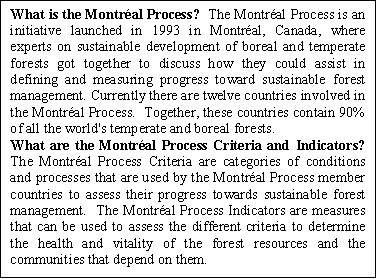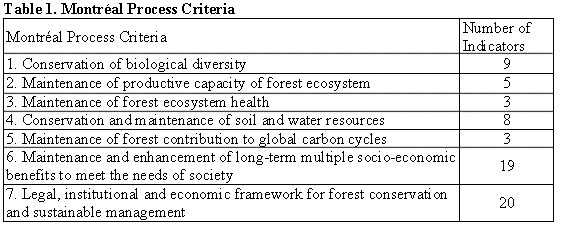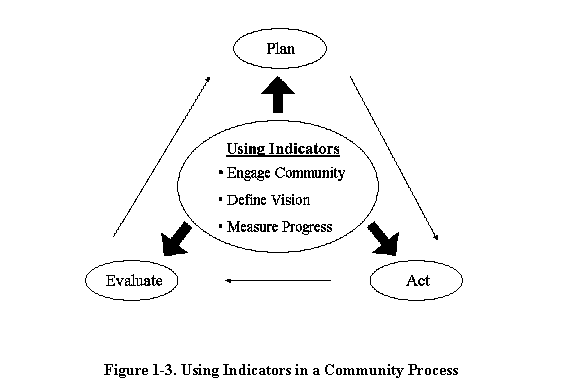 Chapter 1: Introduction Chapter 1: Introduction
Forests and forest-related natural resources are critical components of the long-term economic health and quality of life of both rural and urban communities:
- They provide key environmental functions such as regulation of the water and carbon cycles, purification of the air, and preservation of the biological diversity of birds, mammals and plants.
- Forests are a key element in the local economy because of the various business opportunities they create - from harvesting of timber and other non-timber resources to tourism and recreation.
- On the social side, many people live in a particular area because of their values and spiritual connection to nature and forests. Walking, hiking, biking, skiing, or hunting are just some examples of uses of forests that many people consider essential to their quality of life. In addition, forest-related jobs and activities help to form the cultural identity of many communities.
However, merely realizing that a community depends upon its natural resource base is not sufficient to ensure that those critical assets will continue to provide benefits to the community.  Communities need a process for monitoring and evaluating the state of their natural resources, making plans to maintain and enhance those resources and assessing the effective implementation of their plans and programs. One tool that a growing number of communities around the world are finding useful in this process is sustainability indicators. Communities need a process for monitoring and evaluating the state of their natural resources, making plans to maintain and enhance those resources and assessing the effective implementation of their plans and programs. One tool that a growing number of communities around the world are finding useful in this process is sustainability indicators.
Sustainability indicators are indicators for measuring and monitoring the long-term health and vitality of the economic, social and environmental systems that are needed to maintain quality of life in a community. Many different types of communities from densely populated urban areas to sparsely populated rural areas use sustainability indicators. However, the purpose of this document is to provide information specific to forest-related communities who are interested in using indicators for measuring and monitoring the overall sustainability of their forest-related way of life. This document has been developed specifically for communities with a particular interest in forest resources to help them use sustainability indicators for understanding, monitoring, planning for, and evaluating progress towards becoming a sustainable forest community. Such indicators are needed to ensure the long-term health and productive capacity of forests because:
- Without knowing the baseline conditions and the trends in forest resources, it is difficult to assign priorities to issues.
- Without knowing how different activities affect the resources, it is difficult to plan appropriate actions.
- Without a way to evaluate the success of implemented actions, it is difficult to assess whether programs have the desired effect.
This document has been developed to serve as an indicator 'tool kit' for forest-based communities that are working on maintaining and enhancing the natural resources on which their economic, social and environmental health depends.  As with any tool kit, the tools themselves do not do the work, rather they are implements that communities can use in getting work done. Every community is different, just as every house is different, but as a hammer, chisel, and a saw can be used to build many different types of houses, the tools in this ToolKit can be used by many different communities to help build a system for measuring and monitoring progress towards more sustainable forest management. The ToolKit does not include all the materials needed nor is each tool developed to the exact specifications of any particular community. Rather, each tool can be modified or tailored to fit the needs of each community that has chosen to use it. As with any tool kit, the tools themselves do not do the work, rather they are implements that communities can use in getting work done. Every community is different, just as every house is different, but as a hammer, chisel, and a saw can be used to build many different types of houses, the tools in this ToolKit can be used by many different communities to help build a system for measuring and monitoring progress towards more sustainable forest management. The ToolKit does not include all the materials needed nor is each tool developed to the exact specifications of any particular community. Rather, each tool can be modified or tailored to fit the needs of each community that has chosen to use it.
A key component of this ToolKit is something called the Montréal Process Criteria and Indicators, or the MPC&I for short. The MPC&I is a framework developed to help assess ecological, economic and social aspects of forest resources.  The framework has seven criteria or categories of issues that need to be considered for assessing sustainable forestry. Within the criteria, the MPC&I framework has 67 indicators that can be used to measure and assess sustainable forest management. Table 1 below lists the seven criteria and the number of indicators within each of them. Appendix B and Appendix E provide additional information and specific indicators for each of the criteria. The framework has seven criteria or categories of issues that need to be considered for assessing sustainable forestry. Within the criteria, the MPC&I framework has 67 indicators that can be used to measure and assess sustainable forest management. Table 1 below lists the seven criteria and the number of indicators within each of them. Appendix B and Appendix E provide additional information and specific indicators for each of the criteria.

The MPC&I is not the only framework for organizing information about sustainable forest communities. There are many different ways that information can be organized. Just as a carpenter chooses the most appropriate saw for a particular task, a community should select the framework that is most appropriate for their needs. A number of different frameworks are described in Appendix B that may also be useful for forest-based communities. However, there are a number of reasons that a community would choose to use the MPC&I. Some of the benefits include:
- It helps to develop a common language among the various people and organizations involved.
- The indicators allow establishing the baseline conditions of forests and other natural resources.
- The indicators enable tracking trends in forest health and productivity as well as other related impacts (water hydrology, air quality, employment, etc.)
- The MP C&I provide a way to measure impacts of forests on local socio-economic conditions (e.g., jobs, businesses)
- By establishing a common language and measures, the framework allows local communities to participate in national forest-related policy and decision-making affecting them.
- In many cases people value their forests for some things but don't realize the forest's many other critical functions. The MP C&I allows for a comprehensive evaluation of all forest resources (e.g., carbon cycle, water hydrology, biodiversity and genetic diversity, etc.)
- Last but not least, using indicators promotes better management. There is an old saying that "what gets measured gets managed." Indicators allow identifying critical issues and focus a community's limited resources on addressing these issues first.
As originally developed, the MPC&I framework was intended for use at the national and international levels. However, the MP Criteria are equally relevant to the work and activities that go on in communities and many of the MP Indicators can be adapted to the local community level. This ToolKit was developed as a practical means to assist local communities in using indicators in general and the MPC&I in particular to take charge of their forests and natural resources.
It is important to realize that, by themselves, indicators do not solve problems or make a community and its forest resources sustainable. Becoming more sustainable requires an ongoing process in which the community develops a plan, acts on the plan and then evaluates the results as shown in Figure 1-1.

The process is represented as a circle because there is no set beginning to this community process nor is there a defined end point. Different communities might be at different stages in this process and/or might select a different path to get there. One community may have already developed a plan and be in the implementation phase. Another community may have acted on plans and be ready to evaluate progress to date.
In addition, it is important to realize that the process will change over time. While a community identifies issues, develops plans to address them, and acts on those plans, time moves on and circumstances change. As shown in Figure 1-2, after acting on plans, a community needs to evaluate where the plans and actions have taken them, revise the plans and move on.

However, in order for the planning, acting and evaluating process to be successful in the long run, it is important that:
- the community as a whole is engaged in the process,
- there is a common vision and set of goals directing the process, and
- there is a commonly accepted way to measure progress towards the goals.
It is in these three areas that indicators can be very useful and for which this ToolKit has been developed as illustrated in Figure 1-3.

The rest of the chapters in this document provide material for using indicators in a community process.
- Chapter 2 - Engaging the Community - talks about how indicators can be used as a community engages a larger group of people and includes ideas about who should be involved and how to set up a meeting and what are some additional resources to use.
- Chapter 3 - Defining a Vision and Goals - discusses the importance of having agreement on the critical issues and problems as well as an overall vision of where the community wants to be in 20 or 50 years.
- Chapter 4 - Measuring Progress - outlines the main steps in developing indicators, beginning with the purpose of the indicators, selecting the most appropriate ones, setting targets and implementing the indicators.
Each of the above chapters also refers to some 'tools' that a community may decide to use at each step in the process. These 'tools' are included in the appendices and involve skill-building exercises, case studies, list of forestry-related indicators, and list of resources. The Appendices for the ToolKit are:
- Appendix A - Definitions - sustainable forestry, sustainability, sustainable community, and other useful definitions for working with communities.
- Appendix B - Frameworks for Organizing Indicators - Ways to organize indicators and information to help address all key issues, see links and interpret the information in a more consistent way. Includes examples of several frameworks in addition to MPC&I.
- Appendix C - Exercises - Useful exercises involving indicators at each step.
- Appendix D - Case Studies - How several communities have used indicators.
- Appendix E - Sample Indicators - Forest Sustainability - A 'starter' set of indicators that provide useful examples and explanations of indicators as well as some suggestions for possible data sources.
- Appendix F - Other Resources - Documents, web sites, and organizations that may be useful to communities working on sustainable forestry
- Appendix G - Examples of Sustainable Forestry-Related Goals - Examples of goal statements related to sustainable forestry and sustainable forestry management.
- Appendix H - Presentation Materials - Examples of presentation material that can be used in community indicator processes.

|
